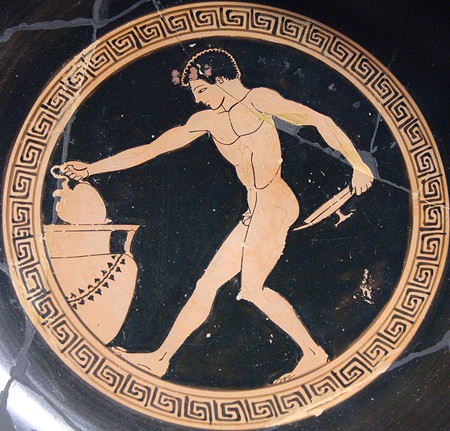Yesterday I read in one of Britain’s wine trade magazines that most people are not interested in being educated about wine, but instead prefer little nuggets of information, or “dinner party one-liners” about the wines they’ve bought. This is according to Justin Howard-Sneyd who is the global consultant for one of the biggest wine companies in the UK. So ever eager to provide a useful service, here’s a selection of nuggets with which you can entertain and amaze your friends. If you learn enough of them, you might qualify for the coveted qualification of Wine Bore of the Year.
 Wine-server at a Greek symposium, ca. 490-480 BC.
Wine-server at a Greek symposium, ca. 490-480 BC.
* Wine is made on every continent except Antarctica.
* The earliest traces of wine were discovered in the Middle East and date from the Neolithic period (8500-4000 BC).
* In ancient Greece, it was expected that the host should drink the first cup of wine to demonstrate that it was not poisoned.
* At the centre of Greek intellectual life was the symposium, which literally means “drinking together.” The symposium reflected the Greek fondness for mixing wine and intellectual discussion.
* Hippocrates, considered the father of medicine, includes wine in almost every one of his recorded remedies. He used it for cooling fevers, as a diuretic, as a general antiseptic, and to help convalescence.
* In ancient Rome it was forbidden for women to drink wine. If a man found his wife drinking wine he would be allowed, by law, to kill her.
* The colour of wine can often tell you where it’s from. The darkest reds and the yellowiest whites invariably come from warm climates.
* A crop of newly-planted vines takes four to five years before grapes can be harvested.
* Almost all wine grapes produce colourless juice. Red wines get their colour from the skins, which are included in the mix when red wines are fermented.
* It’s thought that red wines have many beneficial antioxidants such as polyphenol and resveratrol that could have cardio-protective effects and anti-cancer properties. Grape skins are especially rich in antioxidants so red wines contain more than white wines.
* The Chinese consumed a record 155 million cases of red wine in 2013 thereby beating the French, whose consumption fell to 150 million cases. However, many Chinese people mix red wines with Coca-Cola and Sprite to make them more palatable.
* There are about 400 species of oak, though only about twenty are used in making oak barrels. The average age of a French oak tree harvested to make quality wine barrels is about a hundred and seventy years old.
* Most wines taste of fruit. Only rarely does a wine taste like grapes or raisins and usually it’s made from Muscat grapes.
* In Alabama, it’s illegal to buy any alcoholic beverages by telephone, fax or e-mail.
* It’s illegal to send wine through the US Postal Service, and about half the states ban the shipping of wine even by private carriers.
* Contrary to popular belief, few wines improve with age. Ninety percent of all wines should be consumed within two years.
* It takes about two-and-a-half pounds of grapes to make one bottle of wine.
* Wine is made from about 1,200 different grape varieties.
* The majority of the wine grapes grown in the world are red, the top three being Cabernet Sauvignon, Merlot and Tempranillo.
* Irish folklore has it that fairies are fond of good wine. The proof lies in the fact that when a jug of wine is left out for them at night, it is always gone by the morning.
* People often think of Chile as a relative newcomer to wine production but vines were first planted there in 1554.
And talking of which, Chilean wines continue to offer excellent value especially those from Viña Ventisquero which was established in 1998. The company is one of Chile’s most successful wine producers and during the last five years it has won many accolades. These wines are available at several different outlets, so the prices shown here are just a rough guide.
Ventisquero Clásico Sauvignon Blanc 2013 (white), Chile (Bt. 470 @ various outlets)
This Sauvignon Blanc (SOH-vee-nyon BLAHN) is a greenish-yellow colour and has a lovely fresh, grassy aroma with hints of lemon and herbs. There’s even a suggestion of bananas and pineapples. Sauvignon Blanc generally has a bit more “bite” than Chardonnay, so if your palette is becoming jaded with the ever-present Chardonnay, give this one a try. The fresh taste comes as a pleasant surprise, because some Sauvignon Blancs are so astringent they can make you shudder. But not this one. At just 12.5% alcohol, it has a light smooth body and good fruit. It’s pretty dry of course, but the makers have gone easy on the acid, so that it doesn’t dominate the taste. There’s a good long lemony aftertaste, which makes me feel that the wine could partner some fish dishes or lightly prepared chicken. It would work well with some Thai dishes too, provided that they’re not too fiery. Drink it as cold as you dare.
Ventisquero Clásico Merlot 2012 (red), Chile (Bt. 470 @ various outlets)
This full-bodied Merlot (mehr-LOH) is a deep red, with hints of purple. When you first sniff the wine, you might pick up the faint and pleasing hint of yeast. The aroma has rich, ripe berries with overtones of pepper and herbs. Although the wine is dry, there’s a very fruity taste with the slightest hint of tannin and a long satisfying dry finish too. This wine would be excellent with red meat or assertive pasta dishes, but this is quite a full-bodied job and would almost certainly overpower light meals or chicken, both of which need a lighter – or whiter – wine.
Oh, and before I forget, another interesting nugget. Dark green wine bottles were invented by Sir Kenelm Digby, a seventeenth century English polymath and diplomat, who also managed his family’s coal-fired gasworks. I bet you didn’t know that.




